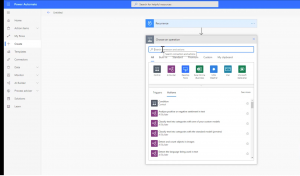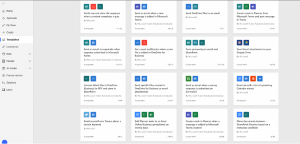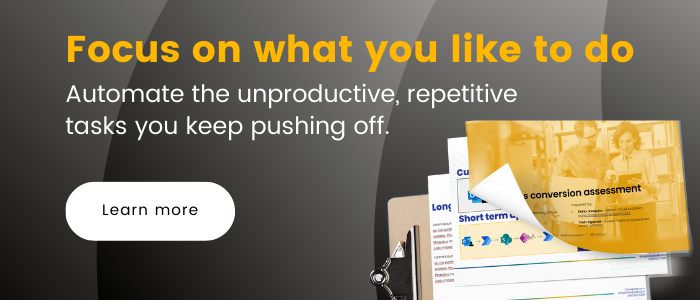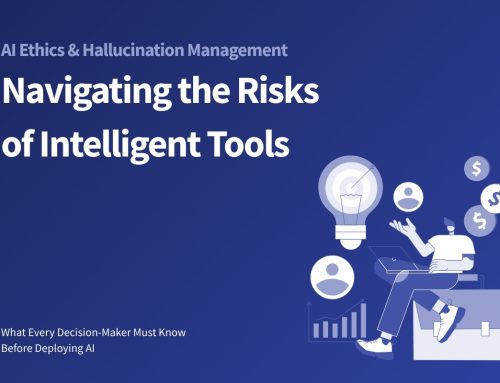Author
Danielle
As one of the five applications available in the Power Platform, Power Automate is the most widely used among our clients and team. It enables users to build flows that automatically complete the repetitive manual tasks they spend so much time on daily. From web scraping, automated alerts, and Twitter analytics to sorting Google Drive, scanning invoices, and calling a database, Power Automate has your back. Even better, due to its integration with the Power Platform, Power Automate users can develop these solutions without any coding experience. Power Automate’s ease of use and versatility, paired with its key benefits, make this service a critical puzzle piece for digital transformations.

The value of Power Automate
Whether you plan on automating an entire process, or just a few steps, automation can free up your time while minimizing the risk of errors, ultimately helping reduce costs. Oh, and it has industry-leading security backing the service; you can’t forget that.
Save time
Smartsheet says you could save upwards of 6 hours every week by replacing repetitive manual processes with automation! With nearly an entire workday saved, employees could spend their time on tasks with higher value. Reducing mindless tasks frees employees to focus on problem-solving and creativity, contributing to a more productive organization.
Reduce errors
Unfortunately, while moving data from one application to another, there’s always the chance of a mistake. When putting Power Automate in charge of these tasks, that chance becomes zero, as computers can repeat a process repeatedly without an error.
Cost savings
Workplace automation can save your business money by streamlining your processes and eliminating costly errors, ultimately helping you complete tasks more efficiently. This may also lead you to use less administrative labor since repetitive, time-consuming tasks will be done automatically. This combination of error reductions and reduced labor enables organizations to spend less time, money, and effort than they would if they needed to account for these things.
Security
Since Power Automate is a Microsoft service, it uses its security, meaning it has a leading cloud security platform protecting it. Using the tried and tested Azure Active Directory, users can seek comfort knowing access to their data and systems is immensely secure.
How it works?
The magic behind Power Automate is the ability to create flows. Users create flows, which map out a step-by-step workflow or process used in their work. Once you set up a flow, Power Automate then waits on a trigger, and when the triggering event occurs, it runs each step of the flow.
There are 3 ways to trigger your flows:
- Automated: starts your flow whenever a certain event happens. Ex: receiving an email invoice from a supplier.
- Scheduled: have your flow run at a certain time of day.
- Instant: manually click a button to kick off the flow.
There are also 2 special types of flows users can build that require a bit more explaining:
1. Business Process flows:
These flows are user experience-centric, meaning it’s all about guiding the user through a process. They are organized in stages, with each stage having its own set of steps. For example, organizations could map out their sales process, from qualifying leads to developing them and closing the deal with additional steps inside each stage. Business Process Flows are used in specific scenarios and are often intertwined with Dynamics 365.

2. Desktop flows:
These flows use Robotic Process Automation, which uses software robots to emulate human actions. To build the flow, users can record the actions they take on their desktop, which software robots then mimic. If you’re familiar with recording Excel Macros, it’s the same concept. Desktop flows are most useful when you need to create flows involving legacy systems that don’t have cloud access. These flows require the user to use Power Automate Desktop, which is free for Windows 10 and above users.
Integrate with other applications
Now that you know how flows work, it’s important to understand how to incorporate various services into your flows. Power Automate —and the Power Platform as a whole— uses connectors. Connectors act as an intermediary between software, allowing them to ‘talk’ to each other. They interpret data in other services and send it back to the Power Platform, allowing you to easily connect to and build with different services and data sources, like Outlook, SQL, SAP, and HubSpot.
Microsoft has over 600 pre-built connectors, enabling you to instantly connect your flow to most of today’s prominent business tools. And if you can’t find a connector for your software, you can build a custom API! When it comes to versatility, Power Automate has your back.
Infuse AI into your flows
Power Automate makes incorporating AI into your flows simple. Microsoft’s AI Builder feature lets anyone–coder or not–make use of the various tasks AI can accomplish. There are currently 13 model types to choose from, some of which include:
- Object detection
- Image classification
- Document processing
- Sentiment analysis
AI builder opens numerous possibilities when it comes to automating your business processes —, it’s up to you to get creative.
Use cases | Power Automate in action
You can deploy a Power Automate flow to do just about anything. To help you better understand why this tool is so nifty, here are a few tangible examples you can use in your organization.
- Approvals: automatically send/receive approval requests for things like holidays, expenses, and claims.
- Store attachments: Save attached documents and files from your email to your OneDrive, Google Drive, or other drives.
- Invoice input: automatically input and save the information from inbound invoices into your database.
Getting started | templates to the rescue:
If you’re feeling overwhelmed and aren’t sure where to begin, we suggest starting with a template. Microsoft provides pre-made templates that are perfect for quickly digitizing your business processes, while also teaching you how the flow-building process works.

There are endless possibilities when it comes to Power Automate. If you have a repetitive business process, you can turn it into a flow. By digitizing your workflows, you can release some of the pressure on your organization, as automating workflows saves time, reduces errors, cuts costs, and increases security. And the best part is that Power Automate connects to just about anything. Whether you need to interact with an Excel sheet or a legacy system, you can create a flow involving any service or system using connectors. The future of completing work-related tasks is here, and Power Automate is leading the way.



















